seat adjustment YAMAHA FZ8 S 2010 Owners Manual
[x] Cancel search | Manufacturer: YAMAHA, Model Year: 2010, Model line: FZ8 S, Model: YAMAHA FZ8 S 2010Pages: 110, PDF Size: 3.01 MB
Page 6 of 110

TABLE OF CONTENTSSAFETY INFORMATION.................. 1-1
DESCRIPTION .................................. 2-1
Left view ......................................... 2-1
Right view ....................................... 2-3
Controls and instruments ............... 2-5
INSTRUMENT AND CONTROL
FUNCTIONS ...................................... 3-1
Immobilizer system......................... 3-1
Main switch/steering lock............... 3-2
Indicator lights and warning lights............................................ 3-4
Multi-function meter unit ................ 3-8
Handlebar switches ...................... 3-11
Clutch lever .................................. 3-13
Shift pedal .................................... 3-13
Brake lever.................................... 3-13
Brake pedal .................................. 3-14
ABS (for ABS models) .................. 3-14
Fuel tank cap ................................ 3-15
Fuel ............................................... 3-16
Fuel tank breather hose and
overflow hose ............................ 3-17
Catalytic converter ....................... 3-17
Seats ............................................ 3-18
Storage compartment .................. 3-19
Rear view mirrors.......................... 3-20
Adjusting the front fork ................. 3-20
Adjusting the shock absorber assembly ................................... 3-22 Luggage strap holders .................. 3-24
Sidestand ...................................... 3-24
Ignition circuit cut-off system ....... 3-25
FOR YOUR SAFETY –
PRE-OPERATION CHECKS ............. 4-1
OPERATION AND IMPORTANT
RIDING POINTS ................................ 5-1
Starting the engine .......................... 5-1
Shifting ............................................ 5-2
Tips for reducing fuel consumption ................................ 5-3
Engine break-in ............................... 5-3
Parking ............................................ 5-4
PERIODIC MAINTENANCE AND
ADJUSTMENT ................................... 6-1
Owner’s tool kit ............................... 6-2
Periodic maintenance chart for the emission control system .............. 6-3
General maintenance and lubrication chart ........................... 6-4
Removing and installing the cowling and panels ...................... 6-8
Checking the spark plugs ............. 6-10
Engine oil and oil filter cartridge.... 6-11
Coolant.......................................... 6-14
Replacing the air filter element ..... 6-16
Adjusting the engine idling
speed ......................................... 6-18 Checking the throttle grip free
play ............................................ 6-19
Valve clearance............................. 6-19
Tires .............................................. 6-20
Cast wheels .................................. 6-22
Adjusting the clutch lever free play ............................................ 6-22
Checking the brake lever free
play ............................................ 6-23
Brake light switches ..................... 6-24
Checking the front and rear brake pads .......................................... 6-24
Checking the brake fluid level ...... 6-25
Changing the brake fluid .............. 6-26
Drive chain slack........................... 6-27
Cleaning and lubricating the drive chain.......................................... 6-28
Checking and lubricating the cables ........................................ 6-29
Checking and lubricating the
throttle grip and cable ............... 6-29
Checking and lubricating the brake and shift pedals............... 6-30
Checking and lubricating the brake and clutch levers ............. 6-30
Checking and lubricating the
sidestand................................... 6-31
Checking the front fork ................. 6-31
Checking the steering................... 6-32
Checking the wheel bearings ....... 6-33
Battery .......................................... 6-33U42PE4E0.book Page 1 Wedne sday, August 6, 2014 3:25 PM
Page 52 of 110
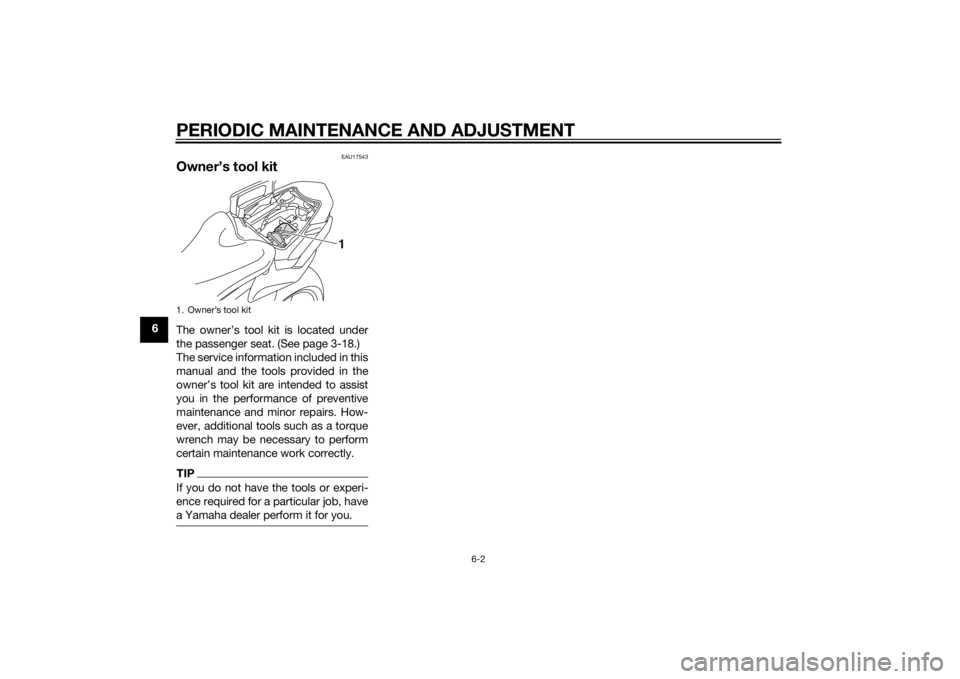
PERIODIC MAINTENANCE AND ADJUSTMENT
6-2
6
EAU17543
Owner’s tool kitThe owner’s tool kit is located under
the passenger seat. (See page 3-18.)
The service information included in this
manual and the tools provided in the
owner’s tool kit are intended to assist
you in the performance of preventive
maintenance and minor repairs. How-
ever, additional tools such as a torque
wrench may be necessary to perform
certain maintenance work correctly.TIPIf you do not have the tools or experi-
ence required for a particular job, have
a Yamaha dealer perform it for you.1. Owner’s tool kit
1
U42PE4E0.book Page 2 Wednesday, August 6, 2014 3:25 PM
Page 63 of 110
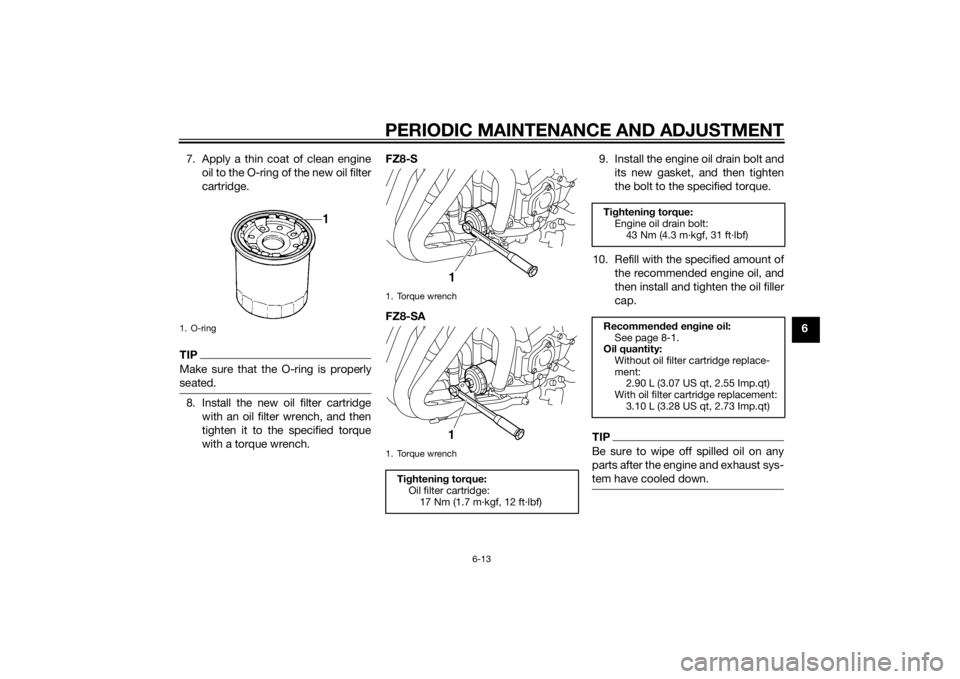
PERIODIC MAINTENANCE AND ADJUSTMENT
6-13
6
7. Apply a thin coat of clean engine
oil to the O-ring of the new oil filter
cartridge.
TIPMake sure that the O-ring is properly
seated.8. Install the new oil filter cartridgewith an oil filter wrench, and then
tighten it to the specified torque
with a torque wrench. FZ8-S
FZ8-SA
9. Install the engine oil drain bolt and
its new gasket, and then tighten
the bolt to the specified torque.
10. Refill with the specified amount of the recommended engine oil, and
then install and tighten the oil filler
cap.
TIPBe sure to wipe off spilled oil on any
parts after the engine and exhaust sys-
tem have cooled down.
1. O-ring
1. Torque wrench
1. Torque wrench
Tightenin g torque:
Oil filter cartridge: 17 Nm (1.7 m·kgf, 12 ft·lbf)
11
Tightenin g torque:
Engine oil drain bolt: 43 Nm (4.3 m·kgf, 31 ft·lbf)
Recommen ded en gine oil:
See page 8-1.
Oil quantity:
Without oil filter cartridge replace-
ment: 2.90 L (3.07 US qt, 2.55 Imp.qt)
With oil filter cartridge replacement: 3.10 L (3.28 US qt, 2.73 Imp.qt)
U42PE4E0.book Page 13 Wedne sday, August 6, 2014 3:25 PM
Page 66 of 110

PERIODIC MAINTENANCE AND ADJUSTMENT
6-16
6
EAU49852
Replacing the air filter ele-
mentThe air filter element should be re-
placed at the intervals specified in the
periodic maintenance and lubrication
chart. Replace the air filter element
more frequently if you are riding in un-
usually wet or dusty areas.
1. Remove the rider seat. (See page 3-18.)
2. Remove panels A and B. (See page 6-8.)
3. Remove the side cowling bolt on both sides. 4. Remove the fuel tank cowling
bolts on both sides after pulling
out slightly on the edge of the side
cowlings to access the bolts.
5. Pull the bottom of the fuel tank cowling outward on both sides,
then remove the cowling by mov-
ing it forward, and then lifting it up. 6. Remove the fuel tank bolt on both
sides.
7. Lift the front of the fuel tank, and carefully tilt it back and away from
the air filter case, but do not dis-
connect the fuel hoses.
WARNING! Make sure that the1. Side cowling bolt
1
1. Side cowling
2. Fuel tank cowling
3. Fuel tank cowling bolt
32
1
1. Fuel tank cowling
1. Fuel tank bolt
1
1
U42PE4E0.book Page 16 Wedne sday, August 6, 2014 3:25 PM
Page 67 of 110
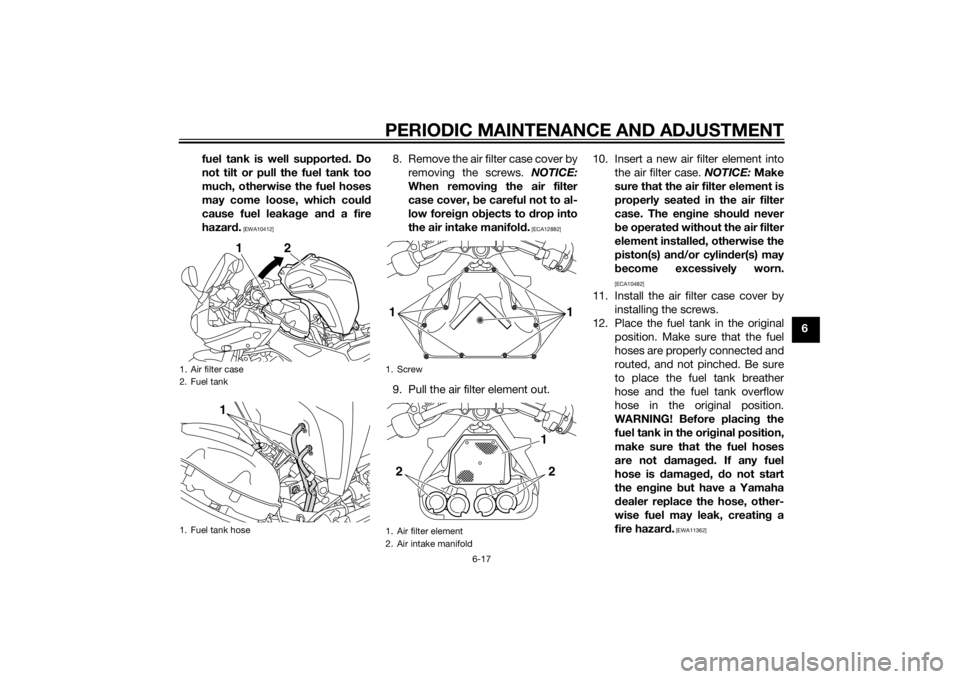
PERIODIC MAINTENANCE AND ADJUSTMENT
6-17
6
fuel tank is well supporte
d. Do
not tilt or pull the fuel tank too
much, otherwise the fuel hoses
may come loose, which coul d
cause fuel leaka ge an d a fire
hazar d.
[EWA10412]
8. Remove the air filter case cover by
removing the screws. NOTICE:
When removin g the air filter
case cover, be careful not to al-
low forei gn o bjects to drop into
the air intake manifold .
[ECA12882]
9. Pull the air filter element out. 10. Insert a new air filter element into
the air filter case. NOTICE: Make
sure that the air filter element is
properly seated in the air filter
case. The en gine shoul d never
b e operated without the air filter
element installed , otherwise the
piston(s) an d/or cylin der(s) may
b ecome excessively worn.
[ECA10482]
11. Install the air filter case cover by
installing the screws.
12. Place the fuel tank in the original position. Make sure that the fuel
hoses are properly connected and
routed, and not pinched. Be sure
to place the fuel tank breather
hose and the fuel tank overflow
hose in the original position.
WARNING! Before placin g the
fuel tank in the ori ginal position,
make sure that the fuel hoses
are not damag ed . If any fuel
hose is damag ed , do not start
the en gine but have a Yamaha
d ealer replace the hose, other-
wise fuel may leak, creatin g a
fire hazar d.
[EWA11362]
1. Air filter case
2. Fuel tank
1. Fuel tank hose
2
1
1
1. Screw
1. Air filter element
2. Air intake manifold
1
1
1
2
2
U42PE4E0.book Page 17 Wedne sday, August 6, 2014 3:25 PM
Page 68 of 110

PERIODIC MAINTENANCE AND ADJUSTMENT
6-18
613. Install the fuel tank bolt on bothsides.
14. Place the fuel tank cowling in the original position, and then install
its bolts on both sides. 15. Install the side cowling bolt on
both sides.
16. Install the panels.
17. Install the rider seat.
EAU34302
A djustin g the en gine i dlin g
spee dThe engine idling speed must be
checked and, if necessary, adjusted as
follows at the intervals specified in the
periodic maintenance and lubrication
chart.
The engine should be warm before
making this adjustment.
Check the engine idling speed and, if
necessary, adjust it to specification by
turning the idle adjusting screw. To in-
crease the engine idling speed, turn
the screw in direction (a). To decrease
the engine idling speed, turn the screw
in direction (b).
1. Fuel tank overflow hose
2. Original position (paint mark)
3. Clamp
4. Fuel tank breather hose
12
43
1. Idle adjusting screw
(b)(a)
1
U42PE4E0.book Page 18 Wedne
sday, August 6, 2014 3:25 PM
Page 76 of 110
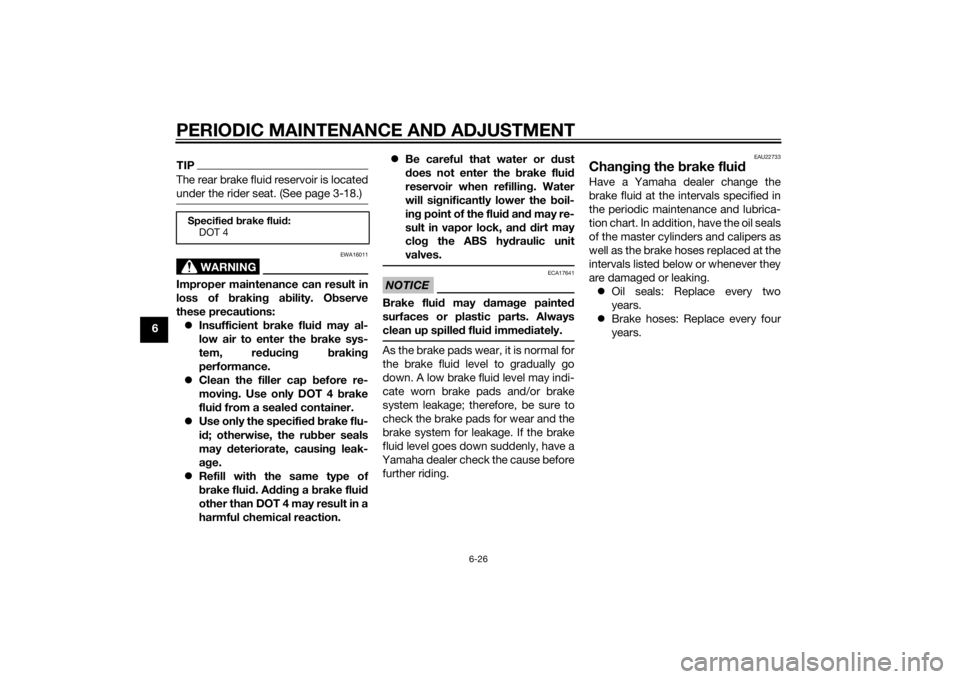
PERIODIC MAINTENANCE AND ADJUSTMENT
6-26
6
TIPThe rear brake fluid reservoir is located
under the rider seat. (See page 3-18.)
WARNING
EWA16011
Improper maintenance can result in
loss of brakin g a bility. O bserve
these precautions: Insufficient brake flui d may al-
low air to enter the b rake sys-
tem, re ducin g brakin g
performance.
Clean the filler cap before re-
moving . Use only DOT 4 b rake
flui d from a seale d container.
Use only the specified b rake flu-
i d ; otherwise, the ru bber seals
may deteriorate, causin g leak-
a g e.
Refill with the same type of
brake flui d. A ddin g a brake flui d
other than DOT 4 may result in a
harmful chemical reaction.
Be careful that water or dust
d oes not enter the brake flui d
reservoir when refillin g. Water
will si gnificantly lower the boil-
in g point of the flui d an d may re-
sult in vapor lock, an d d ir
t may
clo g the ABS hy draulic unit
valves.
NOTICE
ECA17641
Brake flui d may damag e painted
surfaces or plastic parts. Always
clean up spille d flui d imme diately.As the brake pads wear, it is normal for
the brake fluid level to gradually go
down. A low brake fluid level may indi-
cate worn brake pads and/or brake
system leakage; therefore, be sure to
check the brake pads for wear and the
brake system for leakage. If the brake
fluid level goes down suddenly, have a
Yamaha dealer check the cause before further riding.
EAU22733
Chan gin g the brake flui dHave a Yamaha dealer change the
brake fluid at the intervals specified in
the periodic maintenance and lubrica-
tion chart. In addition, have the oil seals
of the master cylinders and calipers as
well as the brake hoses replaced at the
intervals listed below or whenever they
are damaged or leaking.
Oil seals: Replace every two
years.
Brake hoses: Replace every four
years.
Specifie d b rake flui d:
DOT 4
U42PE4E0.book Page 26 Wedne sday, August 6, 2014 3:25 PM
Page 83 of 110
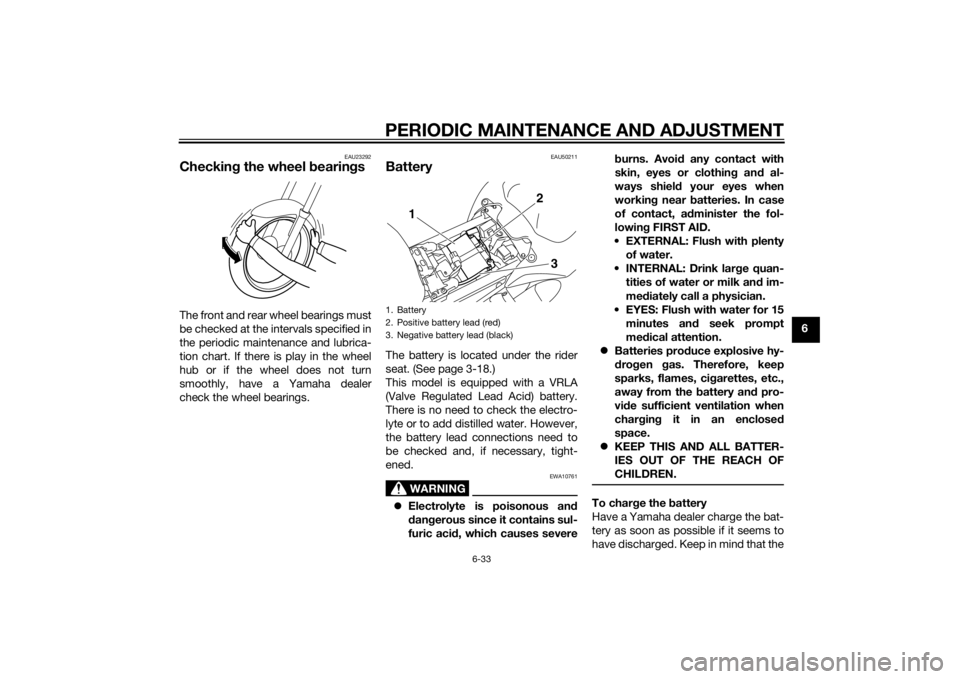
PERIODIC MAINTENANCE AND ADJUSTMENT
6-33
6
EAU23292
Checking the wheel bearin gsThe front and rear wheel bearings must
be checked at the intervals specified in
the periodic maintenance and lubrica-
tion chart. If there is play in the wheel
hub or if the wheel does not turn
smoothly, have a Yamaha dealer
check the wheel bearings.
EAU50211
BatteryThe battery is located under the rider
seat. (See page 3-18.)
This model is equipped with a VRLA
(Valve Regulated Lead Acid) battery.
There is no need to check the electro-
lyte or to add distilled water. However,
the battery lead connections need to
be checked and, if necessary, tight-
ened.
WARNING
EWA10761
Electrolyte is poisonous an d
d an gerous since it contains sul-
furic aci d, which causes severe b
urns. Avoi d any contact with
skin, eyes or clothin g an d al-
ways shiel d your eyes when
workin g near b atteries. In case
of contact, ad minister the fol-
lowin g FIRST AID.
EXTERNAL: Flush with plenty of water.
INTERNAL: Drink lar ge quan-
tities of water or milk an d im-
me diately call a physician.
EYES: Flush with water for 15 minutes an d seek prompt
me dical attention.
Batteries pro duce explosive hy-
d ro gen gas. Therefore, keep
sparks, flames, ci garettes, etc.,
away from the battery an d pro-
vi de sufficient ventilation when
char gin g it in an enclose d
space.
KEEP THIS AND ALL BATTER-
IES OUT OF THE REACH OF
CHILDREN.
To char ge the b attery
Have a Yamaha dealer charge the bat-
tery as soon as possible if it seems to
have discharged. Keep in mind that the
1. Battery
2. Positive battery lead (red)
3. Negative battery lead (black)
1
2
3
U42PE4E0.book Page 33 Wedne sday, August 6, 2014 3:25 PM
Page 84 of 110
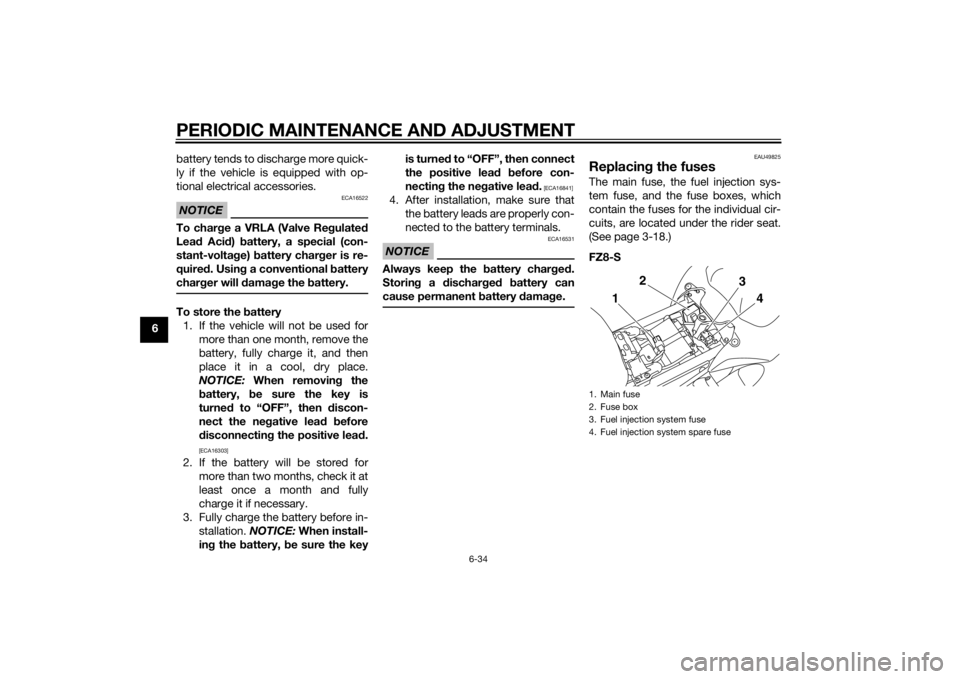
PERIODIC MAINTENANCE AND ADJUSTMENT
6-34
6battery tends to discharge more quick-
ly if the vehicle is equipped with op-
tional electrical accessories.
NOTICE
ECA16522
To char
ge a VRLA (Valve Re gulate d
Lea d Aci d) battery, a special (con-
stant-volta ge) battery char ger is re-
quire d. Usin g a conventional battery
char ger will damag e the b attery.To store the b attery
1. If the vehicle will not be used for more than one month, remove the
battery, fully charge it, and then
place it in a cool, dry place.
NOTICE: When removin g the
b attery, be sure the key is
turne d to “OFF”, then discon-
nect the neg ative lead b efore
d isconnectin g the positive lea d.
[ECA16303]
2. If the battery will be stored for
more than two months, check it at
least once a month and fully
charge it if necessary.
3. Fully charge the battery before in- stallation. NOTICE: When install-
in g the b attery, be sure the key is turne
d to “OFF”, then connect
the positive lea d before con-
nectin g the ne gative lea d.
[ECA16841]
4. After installation, make sure that
the battery leads are properly con-
nected to the battery terminals.NOTICE
ECA16531
Always keep the b attery charged .
Storin g a d ischar ged battery can
cause permanent battery damag e.
EAU49825
Replacin g the fusesThe main fuse, the fuel injection sys-
tem fuse, and the fuse boxes, which
contain the fuses for the individual cir-
cuits, are located under the rider seat.
(See page 3-18.)
FZ8-S1. Main fuse
2. Fuse box
3. Fuel injection system fuse
4. Fuel injection system spare fuse
1
2
3
4
U42PE4E0.book Page 34 Wedne sday, August 6, 2014 3:25 PM
Page 88 of 110

PERIODIC MAINTENANCE AND ADJUSTMENT
6-38
6
EAU32835
Replacing an auxiliary li ght
b ul bThis model is equipped with two auxil-
iary lights. If an auxiliary light bulb
burns out, replace it as follows.
1. Remove panel A (if replacing the left auxiliary light bulb) or panel B
(if replacing the right auxiliary light
bulb). (See page 6-8.)
2. Remove the auxiliary light bulb socket (together with the bulb) by
pulling it out.
3. Remove the burnt-out bulb by pulling it out. 4. Insert a new bulb into the socket.
5. Install the socket (together with
the bulb) by pushing it in.
6. Install the panel.
EAU24116
Replacin g the tail/ brake li ght
b ul b1. Remove the passenger seat. (See
page 3-18.)
2. Remove the tail/brake light bulb socket (together with the bulb) by
turning it counterclockwise.
3. Remove the burnt-out bulb by pushing it in and turning it coun-
terclockwise.
4. Insert a new bulb into the socket, push it in, and then turn it clock-
wise until it stops.
5. Install the socket (together with the bulb) by turning it clockwise.
6. Install the passenger seat.
1. Auxiliary light bulb socket1
1. Auxiliary light bulb1
1. Tail/brake light bulb socket
1
U42PE4E0.book Page 38 Wedne sday, August 6, 2014 3:25 PM